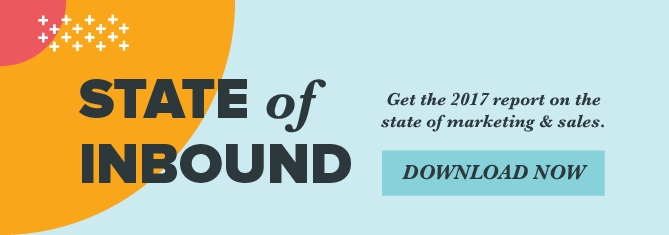It’s finally here! HubSpot’s much-anticipated State of Inbound 2017 is now available to the public and it echoes the sentiments of the B2C and B2B inbound communities through data on top marketing and sales trends and challenges. With responses from more than 6,000 industry professionals, the State of Inbound report demonstrates that more and more companies are recognizing the need to shift their understanding of contemporary marketing to meet consumers on their own turf.
HubSpot draws several conclusions about the data they’ve gathered, but one observation that stands out among the rest is the need for improved cohesion between company executives and the marketing teams they manage. If executives overlook the value of inbound marketing and marketers fail to close the loop by expressing what works, both will lose out on building valuable connections with prospective customers.
To further illustrate this disconnect and frame the current trends and challenges for B2B marketers, we’ve created a brief executive summary of the State of Inbound 2017, highlighting facts and figures most relevant to our B2B community. Use these quick stats and observations to see how your business fits into the future of inbound marketing.
Most Overrated Tactic: Paid Advertising
State of Inbound 2017 respondents overwhelmingly regard paid advertising – namely print and broadcast – as the most overrated marketing tactic. 32% label paid advertising and 11% label online paid advertising as overrated. These statistics align with the relatively new and evolving concept of the “consumer-created environment” that paid simply cannot penetrate. To replace paid efforts, marketers are investing in useful, on-demand content creation to reach more qualified consumers. Hello inbound!
A Sales Solution: Inbound Leads & Alignment
Responses to sales-related queries are consistent with the report’s findings on return on marketing investment (ROMI). 46% said inbound generates higher ROI for their organization than outbound, with inbound practices yielding higher quality leads than outbound and sales team sourcing. Data also shows that responses from companies with poorly aligned sales and marketing teams tend to credit sales with better quality leads, which may reflect wavering confidence in inbound as a viable marketing strategy. Companies that don’t align the two are most likely missing out on quality leads.
Sales Disruptors: Social & Buyer Competency
Modern marketers consider social to be a constant disruptor – a tactic that you can’t live with and can’t live without. Social often clogs ROMI because while it’s difficult to quantify the value of social channels, it’s still necessary to maintain a social presence. For the B2B industry, the most relevant statistic is the most used channel for professional purposes. 78% use LinkedIn, 74% use Facebook and 59% use Twitter for professional posts and interactions. But the smart consumer will always be another constant disruptor, with the presence of information online contributing to this growing challenge.
Trusted Sources: WOM & References
B2B marketers know best that word-of-mouth referrals will remain a big deciding factor in purchasing new products and services. The State of Inbound this year found that word-of-mouth and current customer referrals are the most reliable sources of information for decision makers and over the years more trust has gone to media articles and vendor-authored content over analyst reports. This means c-level decision makers utilize content marketing assets like case studies, refer to others’ experiences and consult articles gained through PR during their purchasing path. B2B marketers, take note!
Marketing Priorities: Traffic & Conversions, SEO & Content
So what should your business prioritize in the years ahead? 70% of State of Inbound respondents consider new lead conversions a top marketing priority and 55% put weight in growing traffic to their website. In terms of inbound marketing efforts, 61% prioritize SEO growth and 53% are focusing on blog creation. These inbound goals are great ways to boost SEO and drive more action on company websites. Whatever you choose to prioritize, make sure your inbound efforts support your larger marketing objectives and you have a reliable way to track ROI.
What do you make of these marketing stats? Read the full report below for more research to draw your own conclusions about HubSpot’s business insights.
Are you interested in B2B content marketing services? Sagefrog’s marketing professionals collectively hold more than 30 HubSpot certifications. Contact Sagefrog Marketing Group today to learn how our inbound expertise can accelerate your success.


